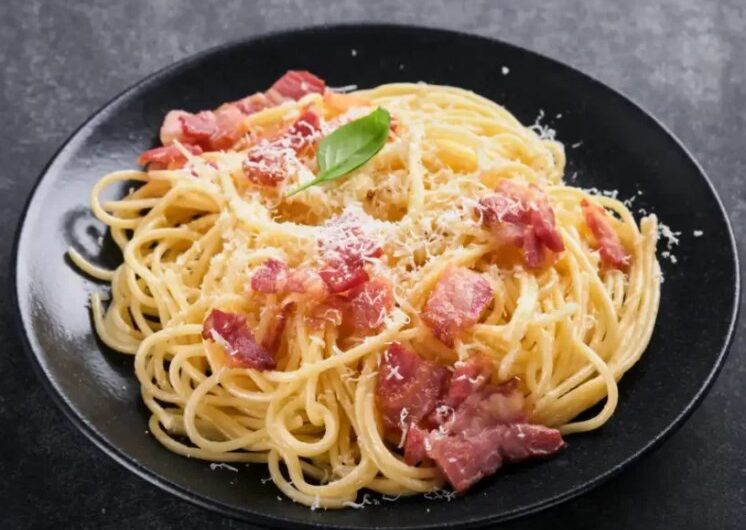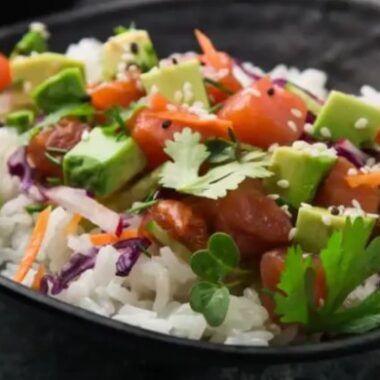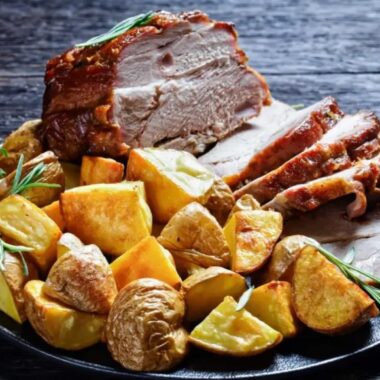4 People
10 mins
15 mins
Pasta Carbonara is a classic Italian dish that combines creamy sauce, savory pancetta, and perfectly cooked spaghetti. It is quick to prepare and incredibly flavorful, making it ideal for weeknight dinners or special occasions.
Reasons to Love This Recipe
- Quick and Easy: This dish is not just delicious but incredibly quick and simple to prepare – perfect for those busy weekdays.
- Rich and Satisfying: The creamy sauce, salty pancetta, and delicate pasta create a flavor-rich experience that is wholesome and filling.
- Versatile Ingredients: It’s adaptable, allowing for a range of creativity and personalization without straying from its classic roots.
- Efficient Use of Pantry Staples: Most of its ingredients are common kitchen staples, which makes it hassle-free to whip up.
The Allure of Pasta Carbonara
It’s easy to see why Pasta Carbonara remains a favorite among pasta lovers. Its understated elegance lies within the balance of simple ingredients, culminating in a dish that tastes far more complex than its preparation might suggest. It’s creamy, savory, and a marvel of texture and flavor that comes together effortlessly. A lot of joy is derived from its adaptability – subtle variations can alter the dish’s characteristic charm, making every serving a delightful culinary experience.
Recipe Overview
Creating an authentic Pasta Carbonara doesn’t involve any complex techniques, making it a suitable endeavor for home cooks of all skill levels. Prepare al dente pasta, fry crisp pancetta, and emulsify egg yolks with grated Pecorino Romano for its signature creamy sauce. Freshly cracked black pepper seals the deal, offering gentle warmth. The full step-by-step recipe is further outlined to ensure success and satisfaction with each attempt. By following the fundamental order and methods, Pasta Carbonara’s age-old flavors light up the table, proving simplicity often yields the most rewarding results.
Nutritional Information
This delightful pasta dish brings a rich array of flavors but also provides a valuable nutritional profile. While undoubtedly a treat, it contains nutrients that are beneficial when consumed in moderation. The dish typically offers about 400-500 calories per serving, with variations depending on the specific ingredients used. The protein content, primarily from pancetta and eggs, reaches around 15-20 grams. The carbohydrates in the pasta account for approximately 40-50 grams, making it a solid energy source. Fat content varies between 20-25 grams, drawn mainly from cheese and pancetta, while fiber content sits at around 2-3 grams, especially if whole-grain pasta is utilized. Adjustments to suit dietary preferences, such as reduced fat options or fiber-rich pasta, maintain its delightful taste and provide a healthier alternative.
Ingredients Overview
- Pasta: Spaghetti remains the classic choice, although bucatini or fettuccine are commendable alternatives, each providing a distinct textural interplay with the sauce.
- Pancetta or Guanciale: Traditionalists lean toward guanciale for its rich, fatty profile. Pancetta or even regular bacon is considered an acceptable substitute, bringing its own flavor twist.
- Egg Yolks: The linchpin of the creamy sauce, utilizing yolks ensures a silky, cohesive blend that adheres beautifully to the pasta strands.
- Pecorino Romano Cheese: This staple enlivens the sauce with a sharp, tangy note, rounded well with a copious sprinkling of freshly ground black pepper.
Step-by-Step Instructions
1. Begin by boiling a pot of salted water, cooking the pasta until just al dente, then retaining a cup of pasta water.
2. While the pasta cooks, cube and fry the pancetta or guanciale until crisp, reserving its fat in the pan.
3. In a separate bowl, whisk egg yolks with Pecorino Romano, blending well with a touch of pasta water for consistency.
4. Introduce the cooked pasta to the pancetta pan, off the heat, then slowly mix in the egg/cheese blend until a silky sauce envelops the pasta.
5. Conclude with ground black pepper and additional cheese, if desired, transferring straight to the plate for immediate enjoyment.
Ingredients
12 ounces spaghetti
6 ounces pancetta or guanciale, diced Can substitute with bacon.
3 large eggs
1 cup grated Pecorino Romano cheese
2 cloves garlic, minced
To taste freshly cracked black pepper
To taste salt
Fresh parsley or basil for garnish Optional.
Directions
- Bring a large pot of salted water to a boil. Cook the spaghetti according to package instructions until al dente. Reserve about 1 cup of pasta water before draining the pasta.
- While the pasta is cooking, heat a skillet over medium heat, add the diced pancetta and cook until crispy, about 5-7 minutes. Add minced garlic and cook for another 1-2 minutes, being careful not to burn it.
- In a mixing bowl, whisk together the eggs, grated Pecorino Romano cheese, and a generous amount of black pepper until combined.
- Once the pasta is drained, quickly add it to the skillet with the pancetta and garlic, tossing to combine. Remove the skillet from heat.
- Slowly pour the egg and cheese mixture over the hot pasta, stirring quickly to combine. Add reserved pasta water, a little at a time, until the sauce reaches your desired consistency.
- Taste and adjust seasoning with salt and more black pepper if needed.
- Serve immediately, garnished with additional cheese and fresh herbs if desired.
Expert Tips
- Perfect Timing: Quickly integrating the egg mixture off-heat prevents scrambling, securing that creamy consistency.
- Keep Pasta Water: Retained pasta water isn’t just an additive but essential, lending necessary emulsion and lusciousness to the sauce.
- Room Temperature Eggs: For an unproblematic mix, bringing eggs to room temperature enables more unified incorporation with pasta.
- Use Fresh Ingredients: The integrity of the dish depends on fresh, quality ingredients, maximizing flavor potential and satisfaction.
Serving Suggestions
Pasta Carbonara makes for a delightful main attraction, yet pairs splendidly with light accompaniments. Green salads or lightly roasted vegetables underscore its richness without overshadowing its essence. Crusty bread additions accentuate the experience, catching the residual sauce. For those interested in wine pairings, a crisp Pinot Grigio or Sauvignon Blanc complements Carbonara’s richness, cutting through and enhancing each balmy mouthful.
Variations and Substitutions
- Add Vegetables: Incorporating peas or spinach introduces freshness and adds nutritional variety.
- Increase Spice: Those with a penchant for heat might introduce a pinch of chili flakes to enliven the dish.
- Try a Vegetarian Twist: Vegetarians can forgo pancetta, opting for umami-rich sautéed mushrooms to achieve a depth of flavor similar to that of traditional meat inclusions.
Storage and Reheating Tips
Pasta Carbonara is most enjoyable when served immediately after cooking, preserving its creaminess and integrity of flavor. Should you have extras, they can be sealed in an airtight container, kept for up to two days in the refrigerator. When reheating, gradual warmth without direct high heat is crucial. Adding a touch of water during this process helps revive lost moisture, ensuring the sauce retains its loved consistency. Although freezing is not recommended due to texture changes, should you choose to do so, reheating with care helps soften potential drawbacks.
FAQ
Q: Can I use cream in the recipe?
A: Traditional carbonara relies solely on egg yolks for creaminess; no cream is necessary. However, a small amount can be incorporated for texture preference.
Q: Is Carbonara safe to eat with raw egg?
A: Proper technique, including the use of residual pasta heat, lightly cooks eggs ensuring safety while maintaining the characteristic sauce.
Q: What pasta substitutes work in a pinch?
A: While spaghetti is classic, linguine or penne can be used interchangeably, each offering unique sauce interaction.
Q: How can I adjust the saltiness?
A: Reduce added salt if using bacon or salty pasta water, allowing control over overall sodium levels without sacrificing taste.
Q: Is it possible to enhance flavor with other ingredients?
A: Additions such as garlic, onion, or herbs can introduce new profiles, yet traditional Carbonara thrives on a minimalistic ingredient palette.






